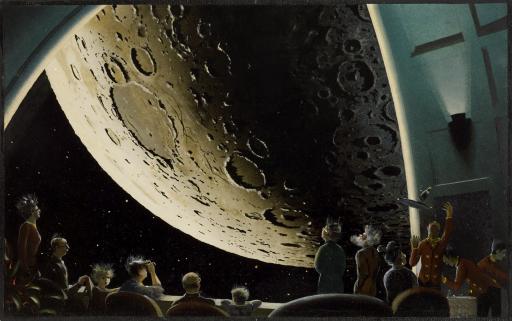“The children laughed at the way everyone’s hair stood on end. The stewardess explained that this was caused by the gravitational pull of the moon.”, Chesley K. Bonestell
Artwork Overview
Chesley K. Bonestell, artist
1888–1986
“The children laughed at the way everyone’s hair stood on end. The stewardess explained that this was caused by the gravitational pull of the moon.”,
1950
Portfolio/Series title: "Mr. Smith Goes to Venus," published in Coronet
Where object was made: United States
Material/technique: cardboard; acrylic
Dimensions:
Image Dimensions Height/Width (Height x Width): 22.7 x 36.6 cm
Image Dimensions Height/Width (Height x Width): 8 15/16 x 14 7/16 in
Sheet/Paper Dimensions (Height x Width): 25.5 x 41.8 cm
Sheet/Paper Dimensions (Height x Width): 10 1/16 x 16 7/16 in
Mat Dimensions (Height x Width): 16 x 20 in
Image Dimensions Height/Width (Height x Width): 22.7 x 36.6 cm
Image Dimensions Height/Width (Height x Width): 8 15/16 x 14 7/16 in
Sheet/Paper Dimensions (Height x Width): 25.5 x 41.8 cm
Sheet/Paper Dimensions (Height x Width): 10 1/16 x 16 7/16 in
Mat Dimensions (Height x Width): 16 x 20 in
Credit line: Gift of Esquire, Inc.
Accession number: 1980.0718
Not on display
If you wish to reproduce this image, please submit an image request





